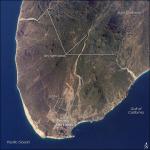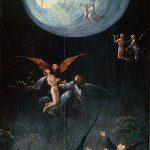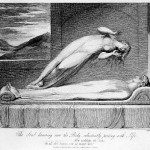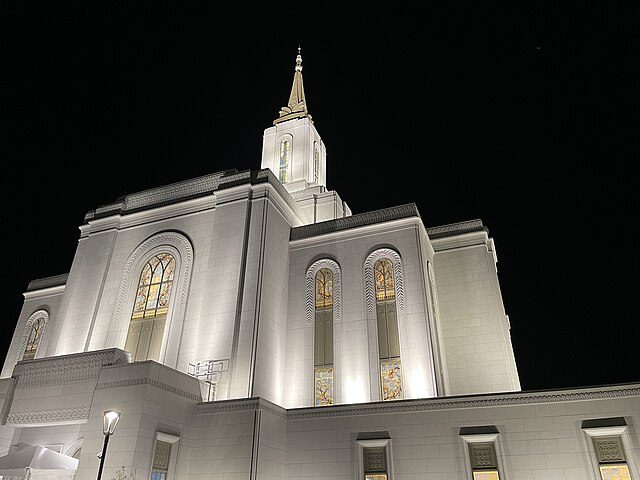
Last night, my wife and I attended the open house for the new Orem Utah Temple. When it is dedicated, it will be our temple. So I was pleased to see how pretty it is on the interior. Particularly its carpets and its stained glass windows. I’ve been disappointed at being unable to volunteer for the open house, but our travel schedule of late has made it completely impossible.
And, speaking of travel, we’re off again in order to spend time with a grandchild. (Part of the blessing or the curse of having a far-flung family is that we’re obliged to travel great distances to see our grandkids.) We were pleased, though, to run into Terryl and Fiona Givens in the Delta Airlines lounge at the Salt Lake Airport while we were waiting for our respective flights. Which allowed for very pleasant conversation. He has an extremely interesting writing project that’s nearing completion.
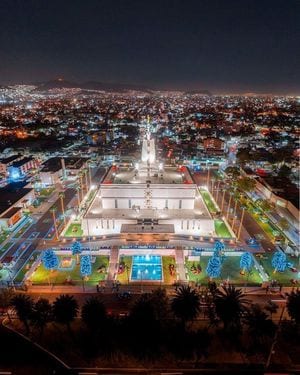
(Image of unknown provenance; if there are copyright concerns, please contact me at daniel_peterson@byu.edu)
I will now share a little bit more from “Comparing Near-Death Experiences and Shared Death Experiences: An Illuminating Contrast,” Journal of Near-Death Studies 40/21 (Summer 2022), 77-94. Authorship of the article is attributed to the “Shared Crossing Research Initiative (SCRI),” a team of researchers based in Santa Barbara, California, but the principal authors appear to have been Michael Kinsella and William Peters.
Both NDEs and SDEs are typically assumed by persons reporting them to be the results of a spirit or soul leaving the body – one’s own spirit or soul in the case of NDEs and the soul or spirit of another in the case of SDEs. (90)
[I]t is important to keep in mind that a variety of features are unique to SDEs, such as remotely sensing a death from a distance and, most notably, encounters with another person in the process of dying. (90-91)
Notwithstanding a few features unique to each experience [NDE and SDE], we observed a striking similarity in both phenomenological features and aftereffects of NDEs and SDEs that supports the idea that they are different perspectives of a singular phenomenon, namely the transition between physical and non-physical existence. (92)
NDEs are often characterized as a “journey to the light” – in this sense, the light takes on a primary role as it is the presumed destination of the dying, though this journey is cut short for NDErs who return to tell their tale. In SDEs, people sometimes report seeing a dying loved one travel up through a tunnel and into the light, or they report seeing unaccounted-for light at some point during their experiences. With few exceptions, people reporting SDEs rarely describe the light as the main feature of their experience; rather, their attention is usually focused on a vision, a sensed presence, or thoughts of a dying person. Some SDErs even describe accompanying or assisting a dying loved one to the light. Given these similarities and differences, NDEs and SDEs both suggest that the person undergoing the experience is witnessing a direct relationship between the appearance of light and the dying process, with the dying individual moving toward or transitioning into the light. (91)
According to some of the SDErs we interviewed, the aspect of their experience identified as a life review consisted of either past moments in the life of the dying person or of past moments that they previously shared with the dying person. In cases of the former, these moments were reported to come not from personal memories but rather from some external agent. In these instances, SDErs reported witnessing past events of which they had no prior direct experience, and sometimes this revelation resulted in the SDEr gaining new insights into the lives of the dying. (91-92)
They discuss the “life review,” something well known from myriads of accounts of near-death-experiences, as it occurs in of the “shared death experiences” that are the principal focus of their research.
One type is illustrated by an experience related by Susan B., from shortly after the death of her boyfriend:
I received a phone call that my boyfriend had died. I was so distraught, so distraught, that after crying for hours, I finally fell asleep, but then I became aware – I would have to say aware – I became aware of a vision, and the vision was a tunnel kind of vision, and it was like images were all on top of each other and moving, and it was everything that he and I had ever done together was going on. I was aware of this image, and I looked at this image, and I knew it wasn’t my life because it was just our life together, so in my mind I screamed, “John’s dead,” at which point the image froze, and then it shattered like a piece of glass. I opened my eyes, I could still see the image, and bit by bit, piece by piece, the glass fell down, and as the image cleared, I could see the room. (86)
The authors also describe another kind of life review, “in which participants described having somehow acquired or having direct access to the private interior life of a dying person” (86). An example to illustrate this comes from Jean D., who described an experience that she had shortly prior to the death of her father:
One day I was out weeding the yard, so I was just by myself, and all of a sudden, I saw a movie of [her father’s] whole life. I’m just by myself doing this weeding, see this movie, and I realize, “Oh my gosh, it’s dad’s life!” When he was younger and he came back from the war, and different times in business, and when my brother was born. And I realized that I was seeing all the highlights of his life, the times when he was most proud. And I thought, “Wow, this is weird. This is really interesting.” (86)
Posted from Cabo San Lucas, Mexico



